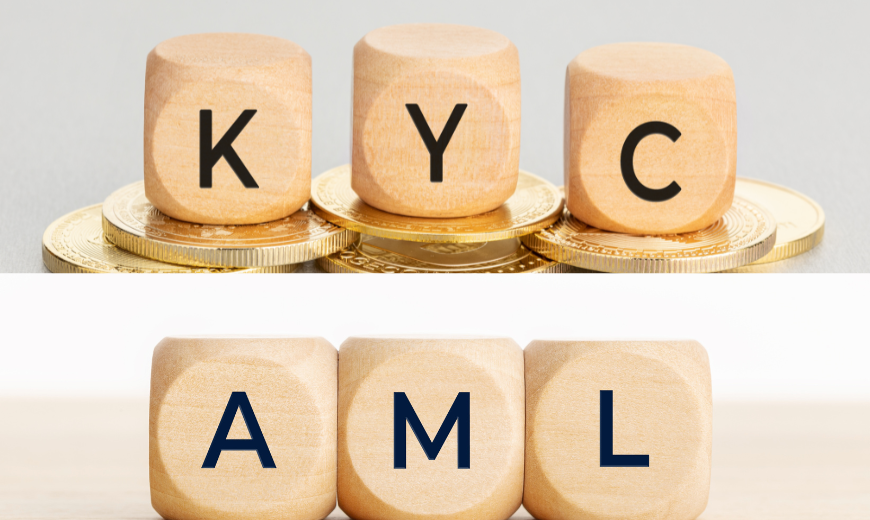
Blockchain technology has been providing promising decentralized solutions to the traditional centralized world for quite some time now. It has the potential to increase transparency and empower transactions, which is indisputable. Join The Blockchainist as we uncover the intersection of KYC/AML protocols in Blockchain technology.
There is a growing concern about exploiting these decentralized platforms. Some certain illicit actors are always lurking around. As transactions dodge traditional oversight, some activities, such as money laundering and terrorist financing, find breeding grounds because of the anonymous nature of the Blockchain networks.
Specific frameworks like KYC /AML (Know Your Customer & Anti-Money Laundering) have been set up to battle this. They have been showing impressive capabilities in safeguarding financial integrity worldwide. These steps make sure that identities are constantly verified and transactions are examined. This approach rebuilds trust and security in an otherwise decentralized ecosystem.
The world of finance has been experiencing a groundbreaking shift ever since Blockchain technology set foot on the scene. Transactions now occur without a central authority, offering high transparency and efficiency. However, the anonymity that empowers users can now be dangerous due to these unexpected activities.
Let’s explore together how these methods adapt to fight unlawful activities while preserving the true potential of decentralization. Unwind the developing strategies & innovations shaping the future of our finance in this interconnected world.
So, let’s get started with our topic of the day.
Illicit Activity in the Blockchain
The very feature that makes blockchain so revolutionary – anonymity – can also be a double-edged sword. While it empowers users with greater control over their finances, it can also attract those with less than noble intentions. Here’s how the anonymity of some blockchain transactions can be misused:
1. Money Laundering: Blockchain transactions can be used to disguise the source of illegal funds. Criminals can move money through multiple anonymous transactions, making it difficult for authorities to track the origin and destination.
2. Terrorist Financing: The ease of transferring funds across borders on blockchain platforms makes it a potential channel for financing terrorist activities. Donations or fundraising for extremist groups can be masked by the anonymity of transactions.
3. Darknet Markets: Blockchain facilitates the operation of darknet markets, which are online marketplaces where illegal goods and services are bought and sold. Cryptocurrencies like Bitcoin can be used for anonymous transactions on these platforms, making it difficult for law enforcement to track down illegal activities.
These illicit activities can negatively impact the legitimacy and trust in blockchain technology. Negative media attention and regulatory crackdowns can stifle innovation and hinder the mainstream adoption of blockchain. Furthermore, the association with illegal activities can erode public confidence and discourage potential users from engaging with blockchain platforms.
KYC/AML: Building Trust in the Blockchain
The fight against illicit activity within the exciting yet potentially risky world of blockchain demands innovative solutions. Here’s where established safeguards like KYC (Know Your Customer) and AML (Anti-Money Laundering) regulations come into play.
Understanding the Guardians:
A. KYC: Imagine walking into a bank for the first time. KYC regulations require financial institutions to verify your identity before opening an account. This helps prevent criminals from using anonymous accounts for illegal activities.
B. AML: Money laundering involves disguising the source of illegal funds. AML regulations aim to prevent this by requiring institutions to monitor transactions and report suspicious activity.
Adapting the Guardians for Blockchain:
While traditional KYC/AML practices work well in centralized systems, adapting them to the decentralized world of blockchain requires ingenuity. Here are some potential solutions:
i. Decentralized Identity Verification (DID): Imagine a digital passport you control. DID allows users to create and manage their own digital identities on the blockchain. This can be used for KYC verification while maintaining user privacy.
ii. Blockchain-based AML Tools: Transaction analysis is crucial for AML compliance. Blockchain technology can be harnessed to build tools that analyze transactions for suspicious activity patterns without compromising user privacy.
These innovative solutions offer a glimpse into a future where KYC/AML and blockchain can coexist. Decentralized identity verification empowers users, while blockchain-based AML tools ensure a safer ecosystem for everyone.
Balancing Security and Privacy in Blockchain
The fight against illicit activity on blockchain brings us face-to-face with a crucial debate: security versus privacy. Implementing robust KYC/AML practices strengthens the ecosystem against criminal misuse, but it can also raise concerns about user privacy.
This lack of privacy could deter users from embracing blockchain technology, hindering its mainstream adoption and innovative potential.
Finding the right balance is key. Here’s why:
1. Trust Fosters Adoption: For blockchain to truly flourish, users need to trust the ecosystem. Strong KYC/AML practices demonstrate a commitment to combating financial crime, building trust and encouraging wider adoption.
2. Privacy is a Core Value: Decentralization is about empowering individuals and giving them control over their finances. Overly intrusive KYC/AML regulations could undermine this core value and drive users away.
The good news is that innovative solutions are emerging to bridge this divide. One promising approach is zero-knowledge proofs. Imagine proving you’re old enough to enter a club without revealing your actual age. Zero-knowledge proofs allow users to verify information (like identity) without disclosing the underlying details, offering a potential solution for KYC compliance while safeguarding user privacy.
While the path forward is not yet fully charted, the combined efforts of developers, regulators, and users can pave the way for a secure and privacy-conscious blockchain ecosystem. In the next section, we’ll explore the importance of collaboration in achieving this goal.
Wrapping Up!
The rise of blockchain technology has given rise to a new era of financial decentralization. However, with its anonymity comes the potential for misuse. We’ve explored the challenges of illicit activity on blockchain platforms and delved into potential solutions.
Key Takeaways:
- Anonymity associated with some blockchain transactions can be exploited for money laundering, terrorist financing, and darknet market activities.
- Strong KYC/AML practices are important for combating illicit activity but require adaptation for the decentralized world of blockchain.
- Decentralized identity verification and blockchain-based AML tools offer promising solutions.
- Striking a balance between security and privacy is crucial to building trust and promoting mainstream adoption of blockchain technology.
- Collaboration between regulators, developers, and users is necessary for developing clear and adaptable regulations and promoting user education.
Want to Learn More?
Visit our blog section for more such relevant content on Blockchain technology and the decentralized world.






